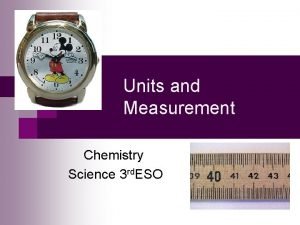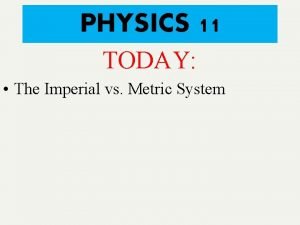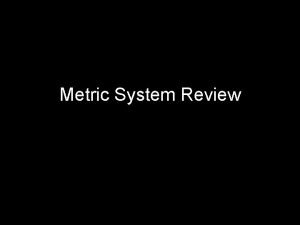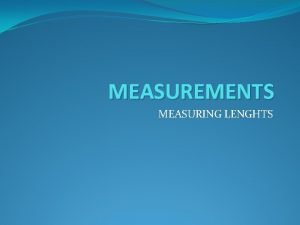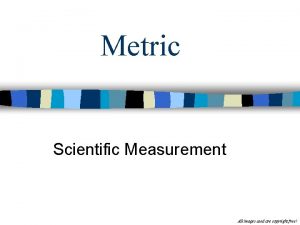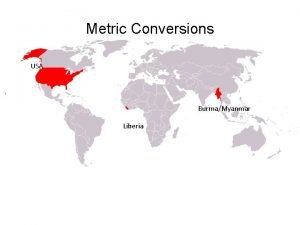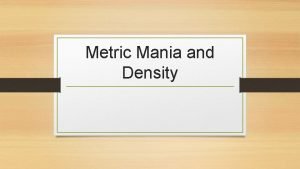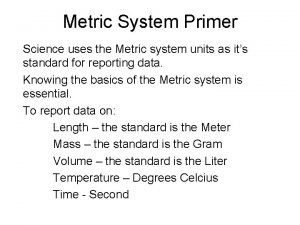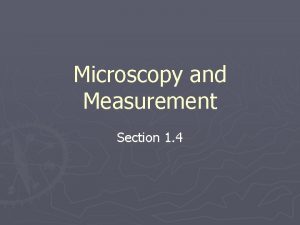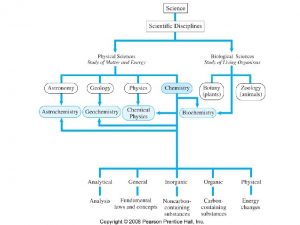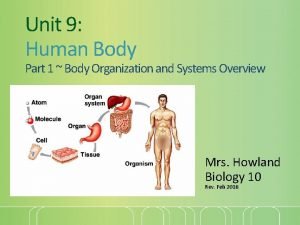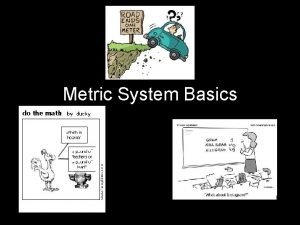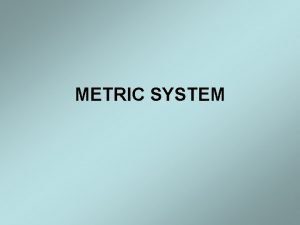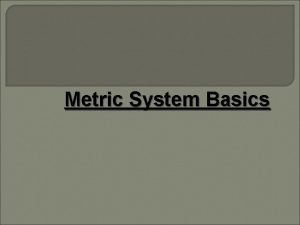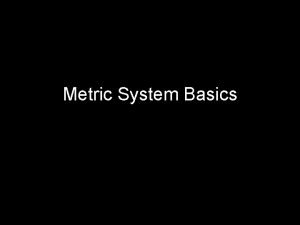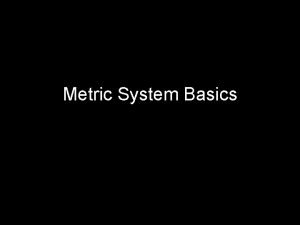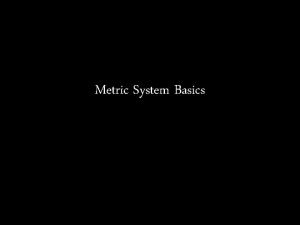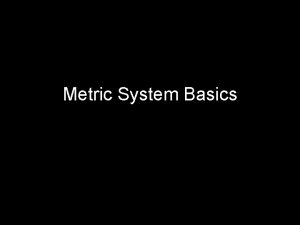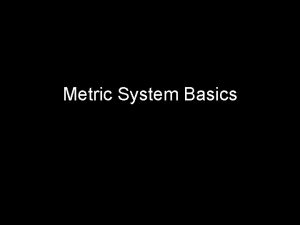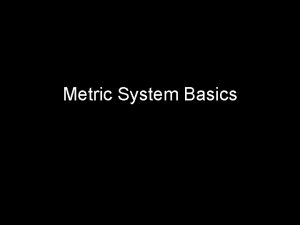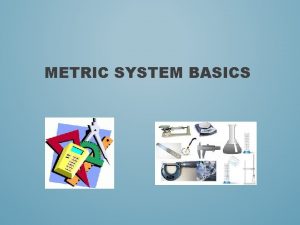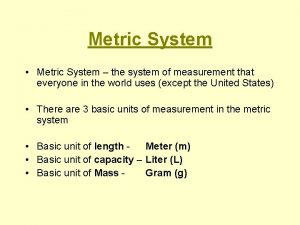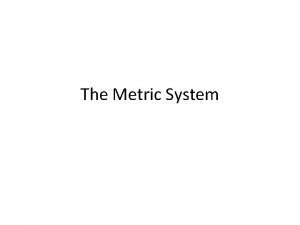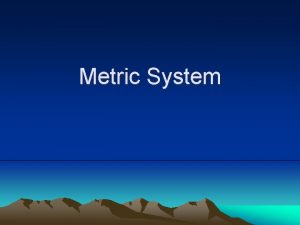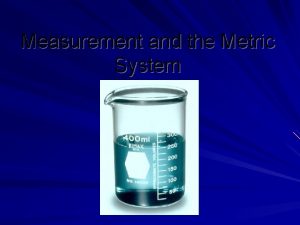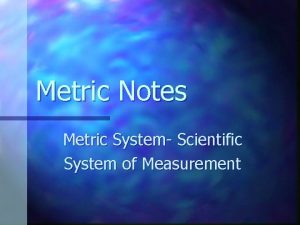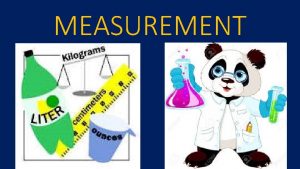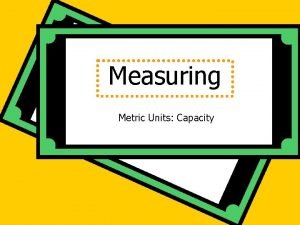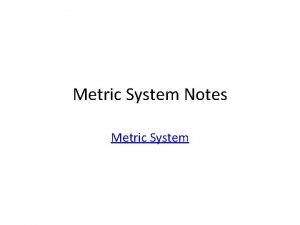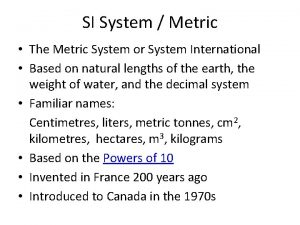Metric System Review Two Systems of Measurement Metric























- Slides: 23

Metric System Review

Two Systems of Measurement • Metric (Systeme International) -Used throughout the world -Used in Science • English -Used in the United States and 1 or 2 other countries

What is the difference? • Metric System • English System • Developed by the French • Very Simple to use • Easy to convert • Used throughout the World • Difficult to use • Difficult to convert • Used in the U. S. and a few other countries

Metric Vs. English system • Metric -Basic Unit of: • English -Basic Unit of: Length- Meter Mass (weight)- Gram Capacity (volume)- Liter Temperature- Celsius Time- Seconds/Minutes Length- inch/foot/yard Mass (weight)ounces/pounds Capacity (volume)Ounce Temperature- Farenheit Time- Seconds/Minutes

Metric System • The metric system is based on a base unit that corresponds to a certain kind of measurement • Length = meter • Volume = liter • Weight (Mass) = gram • Prefixes plus base units make up the metric system – Example: • Centi + meter = Centimeter • Kilo + liter = Kiloliter

Metric System • The three prefixes that we will use the most are: – kilo – centi – milli Base Units kilo hecto deca meter gram liter deci centi milli

How to remember • • Kids (kilo) Have (hecto) Dropped (Deco) Over (base) Dead (deci) Converting (centi) Metrics (milli)

Metric System • These prefixes are based on powers of 10. What does this mean? – From each prefix every “step” is either: • 10 times larger or • 10 times smaller – For example • Centimeters are 10 times larger than millimeters • 1 centimeter = 10 millimeters Base Units kilo hecto deca meter gram liter deci centi milli

Metric System – Centimeters are 10 times larger than millimeters so it takes more millimeters for the same length 1 centimeter = 10 millimeters Example not to scale 40 1 mm 41 1 mm 1 mm 40 1 mm 41 1 cm

Metric Conversions Ladder Method

Metric System • For each “step” to right, you are multiplying by 10 • For example, let’s go from a base unit to centi 1 liter = 10 deciliters = 100 centiliters ( 1 x 10 = 10) = (10 x 10 = 100) 2 grams = 20 decigrams = 200 centigrams (2 x 10 = 20) kilo hecto deca meter liter gram = (20 x 10 = 200) deci centi milli

Ladder Method 1 2 KILO 1000 Units HECTO 100 Units 3 DEKA 10 Units Meters Liters Grams DECI 0. 1 Unit How do you use the “ladder” method? 1 st – Determine your starting point. 2 nd – Count the “jumps” to your ending point. 3 rd – Move the decimal the same number of jumps in the same direction. CENTI 0. 01 Unit MILLI 0. 001 Unit 4 km = _____ m Starting Point Ending Point How many jumps does it take? 4. __. __. = 4000 m 1 2 3

Metric System • An easy way to move within the metric system is by moving the decimal point one place for each “step” desired Example: change meters to centimeters 1 meter = 10 decimeters = 100 centimeters or 1. 00 meter = 10. 0 decimeters = 100. centimeters kilo hecto deca meter liter gram deci centi milli

Metric System • Now let’s try our previous example from meters to kilometers: 16093 meters = 1609. 3 decameters = 160. 93 hectometers = 16. 093 kilometers • So for every “step” from the base unit to kilo, we moved the decimal 1 place to the left (the same direction as in the diagram below) kilo hecto deca meter liter gram deci centi milli

Metric System • If you move to the left in the diagram, move the decimal to the left • If you move to the right in the diagram, move the decimal to the right kilo hecto deca meter liter gram deci centi milli

Metric System • Now let’s start from centimeters and convert to kilometers 400000 centimeters = 4. 00000 kilometers kilo hecto deca meter liter gram deci centi milli

Metric System • Now let’s start from meters and convert to kilometers 4000 meters = 4 kilometers kilo hecto deca meter liter gram deci centi milli • Now let’s start from centimeters and convert to meters 4000 centimeters = 40 meters kilo hecto deca meter liter gram deci centi milli

Metric System • Now let’s start from meters and convert to centimeters 5 meters = 500 centimeters kilo hecto deca meter liter gram deci centi milli • Now let’s start from kilometers and convert to meters. 3 kilometers = 300 meters kilo hecto deca meter liter gram deci centi milli

Metric System • Now let’s start from kilometers and convert to millimeters 4 kilometers = 4000000 millimeters or 4 kilometers = 40 hectometers = 400 decameters = 40000 decimeters = 400000 centimeters = 4000000 millimeters kilo hecto deca meter liter gram deci centi milli

Metric System • Summary – Base units in the metric system are meter, liter, gram – Metric system is based on powers of 10 – For conversions within the metric system, each “step” is 1 decimal place to the right or left – Using the diagram below, converting to the right, moves the decimal to the right and vice versa kilo hecto deca meter liter gram deci centi milli

Conversion Practice Try these conversions using the ladder method. 1000 mg = _______ g 1 L = _______ m. L 160 cm = _______ mm 14 km = _______ m 109 g = _______ kg 250 m = _______ km Compare using <, >, or =. 56 cm 6 m 7 g 698 mg

Metric Conversion Challenge Write the correct abbreviation for each metric unit. 1) Kilogram _____ 4) Milliliter _____ 7) Kilometer _____ 2) Meter _____ 5) Millimeter _____ 8) Centimeter _____ 3) Gram _____ 6) Liter _____ 9) Milligram _____ Try these conversions, using the ladder method. 10) 2000 mg = _______ g 15) 5 L = _______ m. L 20) 16 cm = _______ mm 11) 104 km = _______ m 16) 198 g = _______ kg 21) 2500 m = _______ km 12) 480 cm = _____ m 17) 75 m. L = _____ L 22) 65 g = _____ mg 13) 5. 6 kg = _____ g 18) 50 cm = _____ m 23) 6. 3 cm = _____ mm 14) 8 mm = _____ cm 19) 5. 6 m = _____ cm 24) 120 mg = _____ g

Compare using <, >, or =. 25) 63 cm 26) 536 cm 6 m 53. 6 dm 27) 5 g 28) 43 mg 508 mg 5 g 29) 1, 500 m. L 30) 3. 6 m 1. 5 L 36 cm
 Understanding metric system
Understanding metric system Metric system table
Metric system table Metric volume units
Metric volume units Metric measure
Metric measure Imperial and metric
Imperial and metric Metric system review
Metric system review English and metric units
English and metric units Typical room height appropriate metric unit
Typical room height appropriate metric unit Metric measurement virtual lab
Metric measurement virtual lab Opisometer unit
Opisometer unit Unit conversion staircase
Unit conversion staircase Metric mania notes
Metric mania notes Metric system vs english system chart
Metric system vs english system chart Metric system vs american system
Metric system vs american system Microscopy and measurement section 1-4 review
Microscopy and measurement section 1-4 review Two parts of measurement
Two parts of measurement Chapter review motion part a vocabulary review answer key
Chapter review motion part a vocabulary review answer key Ap gov final review
Ap gov final review Nader amin-salehi
Nader amin-salehi Example of inclusion and exclusion criteria
Example of inclusion and exclusion criteria Narrative review vs systematic review
Narrative review vs systematic review Body organization
Body organization Pltw human body systems final exam
Pltw human body systems final exam Hpi elements cheat sheet
Hpi elements cheat sheet

